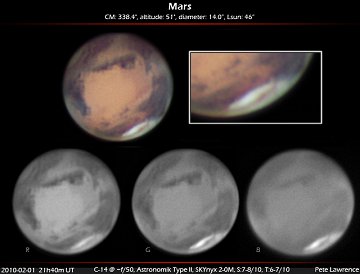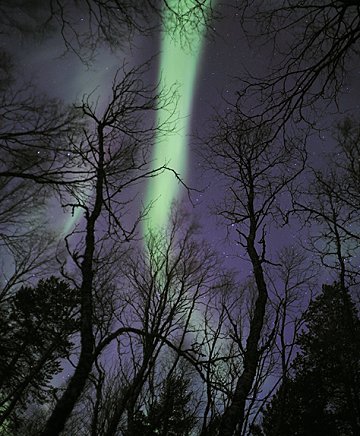SATELLITE FLYBYS APP: Turn your iPhone or iPod into a field-tested satellite tracker! Spaceweather.com presents the Satellite Flybys app. | | | SOLAR DYNAMICS OBSERVATORY: The most advanced solar observatory ever built is set to launch from Cape Canaveral on Feb. 9th. The liftoff of SDO (Solar Dynamics Observatory) such a big event, the staff of spaceweather.com is traveling to Florida to report on it. Until then, watch this movie about SDO from NASA. See also SDO movies for kids. POLAR ACTIVITY ON MARS: Amateur astronomers monitoring Mars have noticed a sudden change in the appearance of the planet's arctic regions. "Over the weekend a dust stream appeared," reports Pete Lawrence of Selsey, UK, "and it is cutting across Mars' north polar cap." He photographed the activity using a 14-inch Celestron: 
Polar dust storms are common at this time of year on Mars. It is springtime in the Martian north. Temperature differences between polar ice and darker regions to the south, which are heated by the springtime sun, stir up winds and streamers of rusty-red dust. In years past, the Hubble Space Telescope has observed dramatic dust storms at the edge of the northern polar cap--and now amateurs are seeing them, too. Train your optics here. more images: from Günther Strauch of Borken, NRW; Germany; from Juan Miguel González Polo of Cáceres, Spain; from Glenn Jolly of Gilbert, Arizona; POLAR ACTIVITY ON EARTH: With the solar wind blowing at high speed, February is shaping up to be a good month for Northern Lights. "Last night around midnight, there was a big outburst of auroras," says Fredrik Broms of Kvaløya, Norway. "The local magnetometer was going wild!" 
He caught these green streamers winding above the tree tops using a Nikon D3 set at ISO 800 for a 3-second exposure. Polar sky watchers should take note of those settings because more auroras are in the offing. A solar wind stream is en route to Earth and it could spark a bright display when it arrives on or about Feb. 10th. Don't miss it. UPDATED: February Northern Lights Gallery
[previous Februarys: 2009, 2008, 2007, 2006, 2004, 2003, 2002] | 
